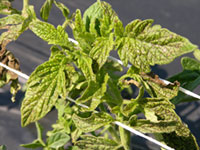 The USDA Tomato Spotted Wilt Virus RAMP Project was a collaborative effort between the University of Georgia, North Carolina State University, University of Florida, Clemson University and USDA-CSREES to facilitate the implementation of reduced risk thrips and tomato spotted wilt virus management in tomato and pepper.
The USDA Tomato Spotted Wilt Virus RAMP Project was a collaborative effort between the University of Georgia, North Carolina State University, University of Florida, Clemson University and USDA-CSREES to facilitate the implementation of reduced risk thrips and tomato spotted wilt virus management in tomato and pepper.
Since 1986, thrips-vectored Tomato Spotted Wilt Virus (TSWV) has become one of the major pests of crops in the Southeast, causing as much as $100 million in damage annually in past years.
Two important crops at-risk from TSWV are fresh tomato and pepper. Production of these crops in Florida, Georgia, North Carolina, and South Carolina represents 43% of the U.S. annual production ($2 billion) and the majority of acreage affected by TSWV.
Tomato Spotted Wilt Virus is transmitted in the Southeast primarily by tobacco thrips and western flower thrips.
 Management of TSWV in tomato and pepper is difficult and involves the use of multiple preventive tactics, including TSWV-resistant plant cultivars, reflective mulch, chemical treatments, and weed management. No single tactic provides 100% control and all must be applied prior to or early during disease spread to be effective. Thus, an integrated multi-tactic management approach based on a pre-season assessment of risk is needed.
Management of TSWV in tomato and pepper is difficult and involves the use of multiple preventive tactics, including TSWV-resistant plant cultivars, reflective mulch, chemical treatments, and weed management. No single tactic provides 100% control and all must be applied prior to or early during disease spread to be effective. Thus, an integrated multi-tactic management approach based on a pre-season assessment of risk is needed.
The goal of this project is to develop a reduced-risk management system for thrips and TSWV in tomato and pepper in the Southeast. The objectives beginning 2008 are to:
- Optimize use of available TSWV management options and define their effectiveness, costs and benefits when used alone and in combination.
- Refine and extend weather-based models for predicting the risk of TSWV spread into crops in spring.
- Develop a risk based decision guide for growers to evaluate the need for and the optimum combination of TSWV management tactics.
- Facilitate implementation of reduced risk thrips and TSWV management in tomato and pepper through a four-state extension program.
This project was funded from 2008-2012 through the United States Department of Agriculture Cooperative State Research, Education, and Extension Service Risk Avoidance and Mitigation Program.
This project was funded from 2008-2012 through the United States Department of Agriculture Cooperative State Research, Education, and Extension Service Risk Avoidance and Mitigation Program.
